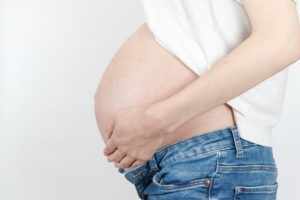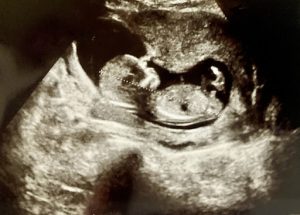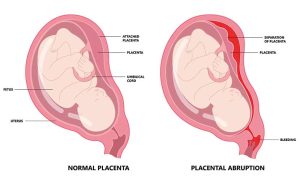Summary of this article
An ectopic pregnancy is a pregnancy in which the fertilised egg implants in a site other than the uterus. If the fallopian tubes have adhesions, stenosis or inflammation, the fallopian tubes become impassable and the fertilised egg cannot be transported normally. If the fertilised egg implants in the fallopian tube, an ectopic pregnancy occurs. There are few subjective symptoms and the condition is often detected by extremely severe abdominal pain due to fallopian tube miscarriage or rupture of the fallopian tubes. It can be treated by surgery or MTX (drug therapy).
What is an extrauterine pregnancy?
An ectopic pregnancy is a pregnancy in which the fertilised egg implants in a site other than the endometrium and the embryo grows. It is commonly referred to as an ectopic pregnancy. However, in medical terms, the concept of ectopic pregnancy includes ectopic pregnancy, which is the most common type of ectopic pregnancy.
What is a normal pregnancy?
Also known as an orthotopic pregnancy, a pregnancy in which the fertilised egg implants in the normal endometrium.
What is an ectopic pregnancy?
A pregnancy in which the fertilised egg implants in a site other than the normal endometrium.
What is an extrauterine pregnancy?
A pregnancy in which the fertilised egg implants in a site other than the uterus.
In other words, all ectopic pregnancies are considered ectopic pregnancies, as they implant outside the normal endometrium. Even intrauterine pregnancies, such as cervical pregnancies and intramuscular pregnancies in the caesarean section wound, are also ectopic pregnancies as they are pregnancies outside the normal endometrium.
The most common type of ectopic pregnancy is implantation in the fallopian tube, tubal pregnancy. It is estimated that approximately 95% of ectopic pregnancies are tubal pregnancies (fallopian tube implantation). An ectopic pregnancy is suspected if the pregnancy test is positive but an ultrasound scan does not show an amniotic fluid-filled sac in the uterus after 6 weeks of pregnancy.
The foetus cannot grow in an implantation outside the uterus. The fallopian tubes are thin tubes and implantation in the fallopian tubes and the growth of the foetus can often lead to rupture of the fallopian tubes. Early detection of an ectopic pregnancy is important because of the risk of intra-abdominal and external haemorrhage in a ruptured fallopian tube.
There is also ovarian pregnancy, which has a similar course and symptoms to tubal pregnancy. An ovarian pregnancy is the implantation of a fertilised egg in the ovarian tissue, but is less common than a tubal pregnancy.
Causes of ectopic pregnancy and recurrence rates
Once fertilisation has taken place, the fertilised egg divides cells as it travels down the fallopian tube to the uterus, where it implants in the endometrium. However, adhesions, stenosis or inflammation of the fallopian tubes can impede their passage, preventing the fertilised egg from being transported normally. If the fertilised egg then implants in the fallopian tube, an ectopic pregnancy occurs.
Adhesions and inflammation of the fallopian tubes are said to be caused by sexually transmitted infections such as chlamydia or common bacteria, but there are many other causes of abnormalities in the fallopian tubes besides sexually transmitted infections. Previous abdominal surgery to the ovaries or fallopian tubes or endometriosis can also be cited. The cause of all ectopic pregnancies is still unknown, although embryo transfer during IVF for infertility treatment has also been implicated.
The recurrence rate of ectopic pregnancy is higher if the woman has had an ectopic pregnancy in the past. It is important to note that the recurrence rate after an ectopic pregnancy rises to about 10%, compared to a typical ectopic pregnancy incidence of about 1-2%.
What is the difference between tubal abortion and tubal rupture?
A tubal abortion is caused by bleeding from the side of the placenta to which the fertilised egg is attached, resulting in detachment of the fertilised egg. The foetal sac and embryo are expelled from the fallopian tube cavity into the abdominal cavity, bleeding from the site of abruption is minimal and usually stops spontaneously. Fallopian tube rupture, on the other hand, occurs when the fallopian tube wall ruptures with the enlargement of the foetal sac. The embryo is expelled into the abdominal cavity and the rupture site is at risk of persistent intra-abdominal haemorrhage.
Main causes of ectopic pregnancy
- Inflammation near the fallopian tubes due to sexually transmitted infections such as chlamydia
- Endometriosis
- Peritubal adhesion
- Oviductal obstruction
- Fallopian tube stenosis
- In vitro fertilisation
- Embryo transfer
- Previous ectopic pregnancy
- Previous caesarean section
- Peritonitis of the pelvis
- Oophorectomy, etc.
The incidence of ectopic pregnancies in women over 40 years of age is also estimated to be more than double that of women in their 20s and 30s. Otherwise, about 2-5% of pregnancies despite the use of intrauterine contraceptives are said to be ectopic pregnancies.
Main symptoms of ectopic pregnancy
Ectopic pregnancies have few subjective symptoms, such as morning sickness, abdominal pain and irregular genital bleeding, as they are not different from normal pregnancies. It is also important to note that many women are unaware of their pregnancy and often misidentify irregular genital bleeding as menstruation. When does the pain from an ectopic pregnancy start?
Most ectopic pregnancies are caused by tubal abortion or rupture of the fallopian tubes, which causes very severe abdominal pain. This is often the first time an ectopic pregnancy is detected, but intra-abdominal haemorrhage can cause shock symptoms and even death.
If you have irregular menstrual periods or irregular genital bleeding on a regular basis, you may be hiding an unexpected condition other than an ectopic pregnancy. It is important to see a doctor as soon as possible, even if you are not aware of any major problems or pregnancy.
How to test for ectopic pregnancy
Ectopic pregnancies have few symptoms. An ectopic pregnancy is often detected by severe abdominal pain due to a ruptured fallopian tube. To avoid the risk of an ectopic pregnancy, it is important to have a thorough pregnancy test when the pregnancy is confirmed. Early detection of an ectopic pregnancy requires a general pregnancy test to know the correct week of pregnancy, an ultrasound and an hCG test.
Pregnancy test
A pregnancy test is an examination to determine the health of the mother and foetus, including the correct number of weeks of pregnancy and the health and growth of the foetus. Pregnancy tests mainly include a medical interview, urinalysis, palpation and internal examination, and ultrasound examination. An ectopic pregnancy cannot be diagnosed in early pregnancy. An ectopic pregnancy requires an ultrasound to confirm the presence of the foetal sac.
hCG test
hCG (human chorionic gonadotropin) is a hormone produced in measurable amounts only during pregnancy. hCG tests are used in over-the-counter pregnancy tests as well as in the diagnosis of abnormal pregnancies, which are common in early pregnancy, such as ectopic pregnancy.
In a normal pregnancy, the hCG concentration more than doubles approximately every two days. However, in ectopic pregnancies, hCG concentrations rise at a slower rate than in normal uterine pregnancies and often remain unchanged or even decrease. Therefore, to test for ectopic pregnancy with the hCG test, the hCG concentration is measured continuously.
Echographic examination (ultrasound)
In the fourth week of pregnancy, an ultrasound scan (ultrasound examination) reveals a black pouch of the foetal sac in the uterus. If, in the fifth week of pregnancy, the ultrasound does not show a foetal sac, there is a high possibility of miscarriage or an ectopic pregnancy.
What is the treatment for ectopic pregnancy?
When an ectopic pregnancy is detected, it often expels spontaneously (spontaneous resolution) if there is no ongoing pregnancy. In the case of an ectopic pregnancy, the foetus is fatal (miscarriage), but with appropriate treatment before rupture, the maternal mortality rate is very low. Ectopic pregnancies can be treated either by surgical resection (operation) or by drug therapy.
Surgical resection (surgical treatment)
Surgical treatment of ectopic pregnancies depends on the condition of the fallopian tubes. Usually laparoscopic surgery is used, but in a few cases open surgery is required. If the fallopian tubes can be preserved, incineration or removal of the fallopian tube and embryo using an ultrasonic scalpel is used.
In ectopic pregnancies where the fallopian tubes have ruptured, a tubectomy is indicated, but only the damaged fallopian tubes are removed. If a pregnancy is then desired, tubal preservation surgery is performed to repair the fallopian tubes to maximise the chance of conception, depending on the ectopic pregnancy.
Methotrexate (MTX therapy)
If the fallopian tube pregnancy is small and unruptured, drug therapy is applied. The drug used is methotrexate (MTX), a type of anticancer drug administered by intramuscular injection. Methotrexate’s ability to inhibit the growth of cancer cells stops the foetus from dividing.
Methotrexate is not covered by insurance for the treatment of ectopic pregnancies. As an anticancer drug, side effects include nausea, white blood cell and platelet loss, and hair loss. However, all side effects are temporary and are expected to recover within a few weeks to three months.
Examples of births due to ectopic pregnancies
A fertilised egg cannot develop outside the womb. Therefore, in the case of an ectopic pregnancy, continued pregnancy is not possible.
However, extremely rare cases of ectopic pregnancies include simultaneous intrauterine and extrauterine pregnancies. This occurs in the case of fraternal twins, where one fertilised egg is implanted in the uterus and the other outside the uterus. Fertilised eggs implanted outside the uterus result in an ectopic pregnancy and do not develop. On the other hand, a fertilised egg that implants inside the uterus can continue to gestate, and there have been reports of healthy babies (foetuses inside the uterus) being born as a result of simultaneous intrauterine and extrauterine pregnancies.
Unfortunately, modern medicine does not allow for the continuation of pregnancy and delivery of a baby due to ectopic pregnancy.
Hiro Clinic NIPT to avoid miscarriage risk
The risk of miscarriage varies outside of ectopic pregnancies. In particular, the risk of miscarriage and premature birth in older pregnancies is 17-18% for women aged 35-39 and 25-30% for women aged 40 and over. Miscarriages in older pregnancies are mainly caused by chromosomal abnormalities in the foetus. Early detection of miscarriage risk can help protect the health of the mother.
Hiro Clinic NIPT offers NIPT for 21 trisomy (Down syndrome), which is highly accurate with a sensitivity and specificity of 99.9% to investigate the possibility of chromosomal abnormalities and congenital disease risk in the foetus.
NIPT requires only a blood sample from the mother. Therefore, there is almost no direct invasion (damage) to the foetus. NIPT at Hiro Clinic NIPT can be performed from the sixth week of pregnancy.
Ectopic pregnancies and miscarriage risks are often triggered regardless of diet and living conditions. For the health of the mother and a healthier pregnancy and delivery. Why not consider NIPT by Hiro Clinic NIPT once the pregnancy is confirmed?
【References】
- Japan Society of Obstetrics and Gynaecology – Miscarriage and imminent miscarriage
- Japan Society of Obstetrics and Gynaecology – Ectopic pregnancy
- MDS household manuals – Ectopic pregnancy
- Doctor’s File – Extrauterine pregnancy
- Department of Women’s Medicine, Japan Medical University – (3) Extrauterine pregnancy (ectopic pregnancy)
- Primary care – Low unit human chorionic gonadotropin
- Actor care – hCG
Q&A
FAQs about ectopic pregnancy for reference.
-
QCan I get pregnant again after an ectopic pregnancy?Many women conceive and give birth naturally after treatment for an ectopic pregnancy. However, the recurrence rate of ectopic pregnancies is not low, at about 10%, so care must be taken to ensure that a thorough examination is carried out if a second pregnancy occurs after an ectopic pregnancy.
It is also possible to conceive through IVF even if the remaining fallopian tubes are in poor condition or if both fallopian tubes have been removed.
Article Editorial Supervisor

Dr Hiroshi Oka
NIPT specialist clinic, MD
Graduated from Keio University, School of Medicine
 中文
中文






















